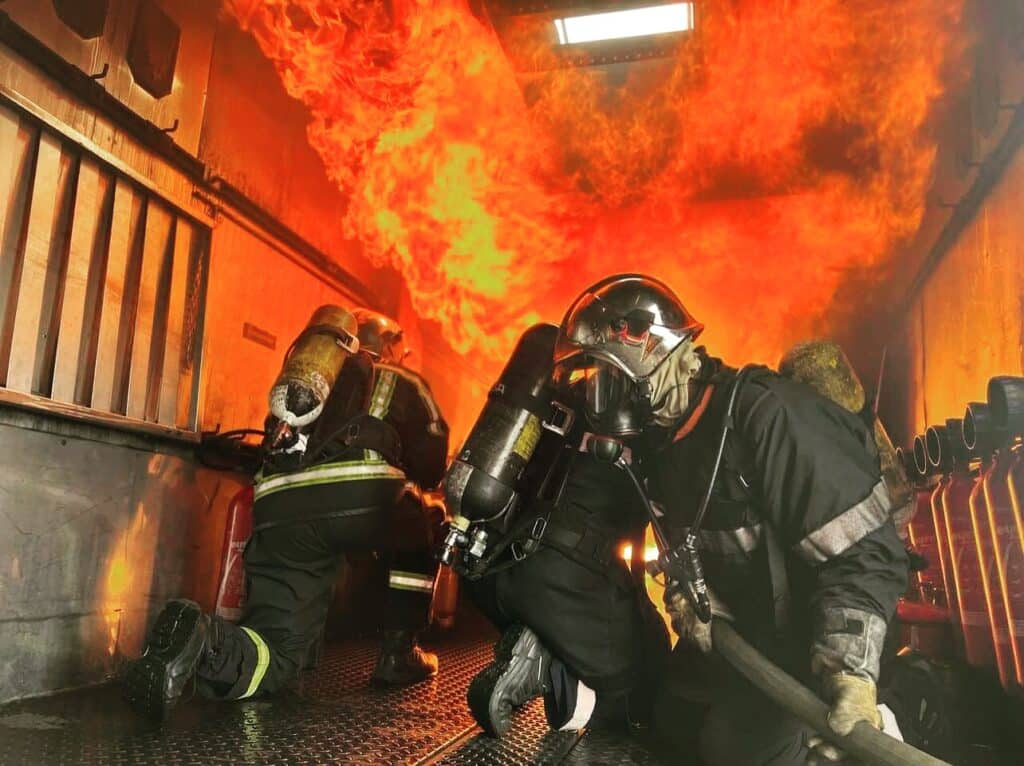What is EPI training?

PPE training, or Équipier de Première Intervention, is a crucial step for those wishing to acquire the skills needed to intervene in the event of a fire. The aim of this training is to enable you to master safety procedures and make effective use of available resources, such as fire extinguishers. It may be compulsory in some companies, and requires regular refresher training. By becoming a first-response team member, you position yourself as the first link in the fire-fighting chain.
Understanding EPI training
La formation EPI inclut des apports théoriques et des exercices pratiques. Les participants y apprennent à identifier les risques d’incendie et à utiliser les équipements de première intervention.
Theoretical courses cover topics such as classes of fire, types of extinguishers and evacuation procedures. Practical exercises provide practice in handling extinguishers and what to do in the event of a fire.
An essential part of the training is also dedicated to coordinating interventions and managing outside assistance. Trainees familiarize themselves with the safety instructions and evacuation circuits specific to their establishment.
Training can last from a few hours to two days, depending on the company's needs and the configuration of its premises.
EPI training objectives
The objectives of PPE training are manifold, and are designed to ensure rapid and effective intervention in the event of a fire. Participants learn to :
- Identify the causes of a fire and its potential effects.
- Master the safety rules specific to their establishment.
- Use fire-fighting equipment such as fire extinguishers and R.I.A. (Robin d'Incendie Armés).
The training also includes practical exercises to simulate real-life situations. This enables trainees to develop appropriate reflexes in the event of a fire.
The skills acquired will also ensure an orderly and safe evacuation of the premises. In addition, participants are trained to effectively alert emergency services.
The target audience for EPI training
Is it compulsory for all employees?
PPE training is not compulsory for all employees, but is strongly recommended. The French Labor Code requires employers to take the necessary measures to ensure that any fire outbreak is quickly brought under control. This includes training certain employees.
Companies with more than 50 employees, or those handling flammable materials, are required to train a sufficient number of first-response team members. In smaller companies, on the other hand, only evacuation and fire alarm simulation training is required.
To ensure an effective response, employers can designate volunteers or select specific employees to undergo this training. These employees then become points of reference in the event of an emergency, ensuring the safety of their colleagues and facilities.
Who can take PPE training?
Employees designated for PPE training can have a variety of profiles. All employees, from administrative staff to blue-collar workers, are eligible for training.
Companies often select volunteers or designate strategic people according to the geographical distribution of their premises. Plant managers may also opt to train department heads or safety committee members.
PPE training is also open to contractors who regularly work on company premises. This includes subcontractors and suppliers.
New recruits can be trained as soon as they arrive, to ensure optimum safety right from the start of their contract. Our training sessions are designed to be accessible to all, with no particular prerequisites.
Benefits for the company
PPE training offers a number of advantages for the company. Firstly, it considerably reduces the risk of fire. By training first-response team members, companies can ensure that the first signs of fire are quickly detected and brought under control, thereby limiting material and human damage.
Secondly, this training contributes to improving overall staff safety. Trained employees are able to raise the alarm effectively and guide their colleagues to assembly points safely. This reinforces employees' confidence in their working environment.
Furthermore, by investing in PPE training, companies comply with their legal obligations in terms of fire safety, thus avoiding potential fines or sanctions. They also demonstrate their commitment to protecting their employees, which can enhance the company's reputation and employee satisfaction.
EPI training content
Learn fire safety procedures
Knowing the different types of fire and how to extinguish them is crucial to fire safety. Participants learn to identify fire classes: A, B, C, D and F, and to use extinguishers specific to each type.
It's also essential to know how to handle an extinguisher: pull the pin, aim at the base of the flames and sweep sideways. To be effective, this handling must be quick and precise.
Trainees must also master evacuation procedures. This includes:
- Recognizing emergency exits
- Organizing a safe evacuation
Finally, realistic scenarios are essential. They enable you to practice what you've learned and react appropriately in the event of a fire. These exercises boost team members' confidence and efficiency in the event of a real emergency.
How to react and organize in the event of an outbreak of fire
When a fire is detected, it's crucial to follow specific steps to ensure everyone's safety. First, raise the alarm using available devices, such as fire alarms, or by calling for help. Then, quickly assess the situation to decide whether direct intervention is possible without endangering your life.
If you are trained and equipped with an extinguisher, use it according to the instructions: pull the pin out, aim at the base of the flames, and activate the device while sweeping sideways. It's essential to set priorities, such as securing the premises and evacuating the most vulnerable people.
Don't forget to coordinate the evacuation by guiding your colleagues to designated assembly points. Make sure no one gets trapped, and that fire doors are closed to limit the spread of fire.
Knowing how to use an extinguisher: is it compulsory?
French legislation does not specifically require all employees to know how to use a fire extinguisher. However, according to article R4227-39 of the French Labor Code, employers must ensure that their staff are trained in fire safety. This training often includes the use of fire extinguishers.
Establishments open to the public (ERP) and high-rise buildings (IGH) are subject to strict obligations. They must train some of their staff in fire extinguisher handling.
Companies can choose to go beyond the minimum requirements by training a larger number of employees. This ensures a rapid and effective response in the event of fire. Here are some actions for employers to consider:
- Organize regular training sessions.
- Update skills every 3 to 5 years.
- Tailor training courses to specific company risks.
Ultimately, investing in fire extinguisher training contributes to greater safety for all.
The first response team: role and missions
The first response team plays a crucial role in a company's fire safety. In the event of a fire breaking out, their main mission is to intervene immediately to try to contain the fire using available resources.
They must also secure the area to enable personnel to evacuate safely. To achieve this, first response team members follow a rigorous training program, covering the various learning phases required to master fire-fighting techniques.
Their intervention is not limited to the use of fire extinguishers. They also learn to use equipment such as RIA (Robinet d'Incendie Armé) and to coordinate with outside emergency services.
Crew members are trained to :
- Raise the alarm quickly in the event of an incident
- Implement evacuation procedures
- Ensuring the safety of occupants and property
These essential missions help to limit material and human damage while waiting for the fire department to arrive.
EPI certification: skills assessment and validation
Skills assessment for EPI certification takes place in several stages. Firstly, a theoretical assessment is carried out using multiple-choice questions and simulated situations. This tests learners' knowledge of the fundamentals of firefighting and safety.
This is followed by a practical assessment to ensure mastery of technical gestures. Learners must demonstrate their ability to use first-response equipment such as fire extinguishers and RIAs.
Formative assessment is carried out throughout the training course, enabling us to monitor participants' progress and adjust our teaching to meet their needs. A summary booklet is often provided to summarize skills acquired and identify areas requiring improvement.
The skills validated are then recorded in a certificate, guaranteeing that the team member is able to intervene in the event of a fire.
Recycling in PPE training: why and how?
The importance of retraining to maintain skills
Refresher PPE training is essential to maintain skills and guarantee responsiveness in the event of an emergency. Refresher sessions allow you to refresh the theoretical and practical knowledge acquired during initial training.
They generally include practical exercises, such as handling fire extinguishers and simulating real-life fires. The value of refresher training lies in the updating of procedures and techniques, in line with technological and regulatory developments.
As skills are only valid for a limited period of time, it is crucial to update them regularly. Case studies drawn from real-life incidents also enrich the sessions, providing concrete examples for a better understanding of the issues at stake.
What's more, these training courses reinforce the cohesion and efficiency of the first response team.
PPE retraining frequency
Refresher PPE training sessions need to be scheduled regularly to ensure that first response team members remain effective. In general, it is recommended to attend these sessions every year.
During these courses, participants update their skills through practical exercises and theoretical updates.
Some companies choose to retrain their employees every 12 months to maintain a high level of preparedness. Others prefer to retrain every 24 months, depending on the specific risks of their business.
Current standards, such as APSAD R6, can also influence the frequency of retraining.
To maximize effectiveness, we recommend varying the fire scenarios covered during training courses. This enables team members to be prepared for a multitude of possible situations.



